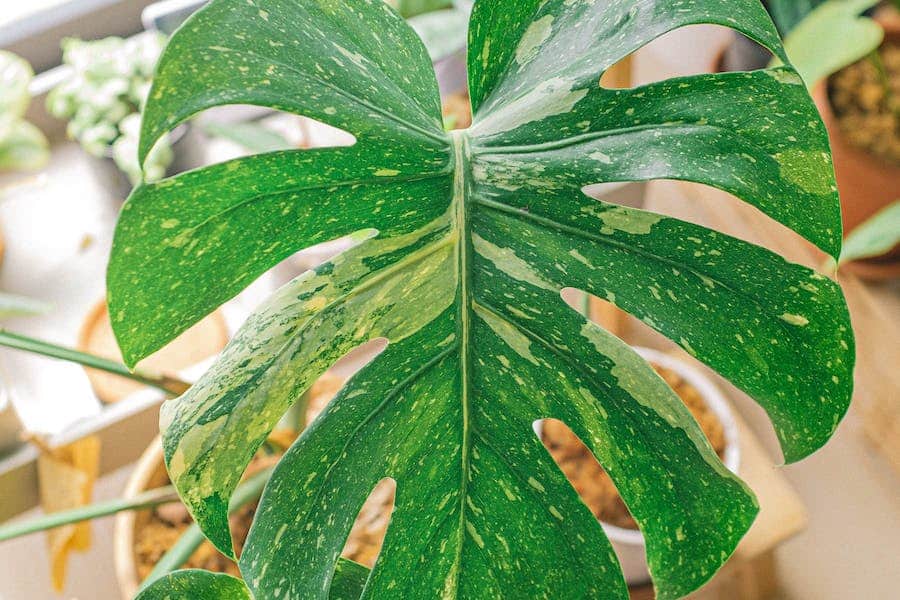The peace lily, with its lush green leaves and elegant white blooms, is a favorite among indoor plant enthusiasts, often gracing living rooms, offices, and even bedrooms with its serene beauty. Its popularity doesn’t just stem from its aesthetic appeal; peace lilies are also hailed for their relatively easy care regimen and air-purifying qualities. However, as with all plants, it’s not uncommon for caretakers to encounter occasional hitches in their plant’s well-being. One of the most common yet perplexing issues many face is the disconcerting sight of the peace lily’s vibrant green leaves turning an unhealthy shade of yellow. Is this a signal of distress? A natural phase in its lifecycle? Or perhaps a mere hiccup in its care routine? Understanding the root causes of this yellowing phenomenon is crucial for any plant parent seeking to restore their peace lily to its full verdant glory. In this post, we’ll delve deep into the reasons behind this change, offering insights and solutions to ensure your peace lily remains a vibrant centerpiece in your space.
Why Is My Peace Lily Turning Yellow?
Peace lilies turning yellow can be attributed to several factors. Commonly, overwatering or underwatering are the culprits. Ensuring a consistent watering schedule is crucial. Additionally, they prefer indirect light, so prolonged direct sunlight can harm them. Check for pests like spider mites or diseases, which can also lead to yellowing. Lastly, consider the potting conditions: well-draining soil in a pot with good drainage helps. Periodically inspect your plant, adjust care routines as needed, and remember—occasional yellow leaves can also be a natural part of its lifecycle!
Overview Of The Peace Lily Plant
The Peace Lily, scientifically known as Spathiphyllum, stands out as one of the most popular and visually appealing indoor plants around the globe. Its reputation is not just built on its aesthetic allure but also its ability to thrive in indoor conditions and its acclaimed air-purifying qualities.
- Origin And Habitat: Hailing from the tropical rainforests of Central and South America, Peace Lilies are accustomed to warm, humid conditions with dappled light. This origin explains their preference for indirect sunlight and moisture-rich environments, replicating the understory of a rainforest.
- Appearance: At first glance, the Peace Lily captivates with its lush green foliage, a backdrop for its most distinctive feature: the white, sail-like spathe that appears to be a flower. In reality, the true flowers are the tiny yellow or white structures located on the spadix, which is the protruding center of the spathe. Over time, the white spathe may turn green, a transformation that aligns with the natural lifecycle of the plant.
- Care Requirements: Caring for a Peace Lily isn’t particularly demanding, making it a favorite among both novice and experienced plant enthusiasts. It thrives in indirect sunlight, ensuring its leaves don’t get scorched. Overwatering can be detrimental, leading to root rot, while underwatering may cause the plant to droop. Thankfully, Peace Lilies are quite communicative; a drooping plant is a clear sign that it’s thirsty. A well-draining soil mix ensures that the roots remain healthy, preventing water stagnation.
- Air-Purifying Qualities: One of the standout features of the Peace Lily, bolstering its indoor popularity, is its ability to purify the air. According to studies conducted by NASA, Peace Lilies can absorb and neutralize harmful indoor pollutants like formaldehyde, benzene, and ammonia. This makes them not only a beautiful addition to homes and offices but also a functional one, contributing to a healthier indoor environment.
- Propagation And Growth: Peace Lilies typically grow between 1 to 4 feet tall, but this can vary based on the specific variety and care given. They can be propagated using a method called division. This involves splitting the plant at its roots, allowing plant enthusiasts to multiply their collection or share it with friends. They tend to bloom in the late spring, producing their signature white spathes, which can last for weeks.
- Common Issues: While relatively hardy, Peace Lilies are not without their share of potential problems. Yellowing leaves, as previously discussed, can be a signal of inconsistent watering, exposure to direct sunlight, or a pest infestation. Speaking of pests, mealybugs, spider mites, and aphids can sometimes be attracted to the plant. Regular inspections and early interventions can help mitigate these issues.
Common Causes Of Yellowing Leaves
Yellowing leaves, a phenomenon known as chlorosis, can be alarming for plant enthusiasts, from novices to seasoned green thumbs. A plant’s leaves are often seen as indicators of its overall health. When those once vibrant green leaves start to turn yellow, it’s a clear sign that something might be amiss. Understanding the potential causes of this discoloration can be instrumental in taking corrective action and ensuring your plant’s long-term health.
- Overwatering: Perhaps the most common mistake, especially among new plant owners, is overwatering. When a plant receives too much water, it can lead to root rot, a condition where the roots become mushy and decayed. This limits their ability to absorb nutrients, leading to yellow leaves. Ensuring a well-draining soil mix and appropriate watering intervals based on the specific needs of the plant is critical.
- Underwatering: At the other end of the spectrum, not providing enough water can also cause leaves to turn yellow. Plants rely on water for various metabolic processes. Without adequate hydration, the leaves may start to yellow and eventually drop.
- Poor Light Conditions: Plants have specific light requirements. Those that are exposed to too much direct sunlight can experience sunburn, leading to yellow or brown patches on the leaves. Conversely, plants receiving insufficient light might also exhibit yellowing as they’re unable to photosynthesize efficiently.
- Nutrient Deficiencies: Plants derive essential nutrients from the soil. Over time, these nutrients can become depleted, especially in potted plants. A lack of vital nutrients, such as nitrogen, potassium, or magnesium, can cause leaves to yellow. Regularly replenishing the soil or using appropriate fertilizers can address this issue.
- Pests And Diseases: Various pests, like aphids, spider mites, and mealybugs, can cause significant stress to plants, often leading to yellowing leaves. They do so by sucking out the sap, which deprives the plant of essential nutrients. Additionally, fungal and bacterial diseases can impede a plant’s ability to function normally, leading to chlorosis.
- Natural Aging: It’s important to recognize that yellowing leaves aren’t always a cause for concern. As plants age, it’s natural for older leaves to turn yellow and eventually fall off to make way for new growth. This is part of the plant’s natural lifecycle.
- Improper Soil Ph: Plants have an ideal pH range in which they can best absorb nutrients from the soil. If the soil is too acidic or too alkaline, it can impede nutrient uptake, leading to yellowing leaves. It’s advisable to periodically test the soil’s pH and adjust it as necessary.
How Do You Fix Yellow Leaves On A Peace Lily?
A flourishing Peace Lily is a sight to behold, with its vibrant green leaves and signature white blooms. However, when those green leaves start to turn yellow, it can be a cause for concern. Here’s a guide to help you diagnose and rectify the issue of yellowing leaves on your Peace Lily.
Check The Watering Routine:
Overwatering and underwatering are the most common culprits behind yellow leaves on Peace Lilies. If the soil feels soggy or there’s standing water in the saucer, you’re likely overwatering. Let the soil dry out a bit before watering again. Conversely, if the soil is bone dry and the plant looks droopy, it’s a sign of underwatering. Water the plant thoroughly, allowing excess moisture to drain away.
Examine Light Exposure:
Peace Lilies thrive in indirect light. If your plant is exposed to direct sunlight, its leaves can get scorched, leading to yellowing. Relocate your Peace Lily to a location where it receives bright but indirect light. If your plant is in a very dark spot, consider moving it to a brighter location or using artificial plant lights.
Inspect For Pests And Diseases:
Spider mites, mealybugs, and aphids can stress a Peace Lily, leading to yellow leaves. Regularly inspect your plant for any signs of these pests. If found, you can treat the plant with insecticidal soap or neem oil. Fungal and bacterial infections can also lead to yellowing leaves. Remove affected leaves and ensure the plant is in a well-ventilated area.
Review Soil And Potting Conditions:
Ensure your Peace Lily is potted in a well-draining soil mix. If water isn’t draining properly, consider repotting the plant in fresh soil. Make sure the pot has drainage holes to prevent water from becoming stagnant at the bottom, which can lead to root rot.
Address Nutrient Imbalances:
Yellow leaves can indicate a nutrient deficiency. A balanced, water-soluble fertilizer, applied as per label instructions, can help provide essential nutrients. However, be cautious not to over-fertilize, as this can exacerbate the problem.
Ensure Optimal Environmental Conditions:
Peace Lilies prefer a humid environment. If you’re in a particularly dry climate or using indoor heating, consider placing a humidifier nearby or placing the plant on a tray filled with water and pebbles. This increases the humidity around the plant. Moreover, shields your plant from drafts and sudden temperature changes.
The Final Words
In sum, a Peace Lily turning yellow is its way of signaling distress or a change in its environment. Whether it’s due to watering inconsistencies, light imbalances, pests, diseases, or other factors, these symptoms act as a call to action for caregivers. Recognizing and addressing the root cause promptly is crucial to reviving and maintaining the plant’s health. As with all living organisms, understanding and catering to its needs is key. By staying observant and responding to the tell-tale signs, you can ensure your Peace Lily continues to flourish as a verdant and vibrant companion in your space.
FAQ’s
Should I Cut Yellow Leaves Off Peace Lily?
Yes, you should cut off the yellow leaves from a Peace Lily. Removing these leaves not only improves the plant’s appearance but also allows the plant to direct its energy towards healthier leaves and new growth. When pruning, use sharp, sterilized scissors or pruning shears and make clean cuts close to the base of the leaf.
Do Peace Lilies Need Direct Sunlight?
No, Peace Lilies do not require direct sunlight. In fact, direct sunlight can scorch their leaves, leading to brown spots or patches. Peace Lilies thrive best in bright, indirect light. They can also tolerate low-light conditions, making them excellent indoor plants, but they may produce fewer flowers in low-light environments. Ideally, placing them near a window with sheer curtains or further away from a direct light source is optimal.
What Does An Overwatered Peace Lily Look Like?
An overwatered Peace Lily will often have yellowing leaves, especially at the base. The plant may appear droopy or wilted, even though the soil is moist. The roots might become mushy, black, or emit a foul odor, indicating root rot. In severe cases, you may also notice brown or black spots with yellow halos on the leaves, which are indicative of a fungal infection due to excess moisture.




















Leave a Reply